Related Research Articles

Cherokee County is a county located in the U.S. state of Oklahoma. As of the 2020 census, the population was 47,078. Its county seat is Tahlequah, which is also the capital of the Cherokee Nation.

Tahlequah is a city in Cherokee County, Oklahoma located at the foothills of the Ozark Mountains. It is part of the Green Country region of Oklahoma and was established as a capital of the 19th-century Cherokee Nation in 1839, as part of the new settlement in Indian Territory after the Cherokee Native Americans were forced west from the American Southeast on the Trail of Tears.

The State of Sequoyah was a proposed state to be established from the Indian Territory in the eastern part of present-day Oklahoma. In 1905, with the end of tribal governments looming, Native Americans of the Five Civilized Tribes—the Cherokee, Choctaw, Chickasaw, Creek (Muscogee), and Seminole—in Indian Territory proposed to create a state as a means to retain control of their lands. Their intention was to have a state under Native American constitution and governance. The proposed state was to be named in honor of Sequoyah, the Cherokee who created a writing system in 1825 for the Cherokee language.

The United Keetoowah Band of Cherokee Indians in Oklahoma is a federally recognized tribe of Cherokee Native Americans headquartered in Tahlequah, Oklahoma. According to the UKB website, its members are mostly descendants of "Old Settlers" or "Western Cherokee," those Cherokee who migrated from the Southeast to present-day Arkansas and Oklahoma around 1817. Some reports estimate that Old Settlers began migrating west by 1800, before the forced relocation of Cherokee by the United States in the late 1830s under the Indian Removal Act.
Jesse Bartley Milam (1884–1949) was best known as the first Principal Chief of the Cherokee Nation appointed by a U.S. president since tribal government had been dissolved before Oklahoma Statehood in 1907. He was appointed by President Franklin D. Roosevelt in 1941, who reappointed him in 1942 and 1943; he was reappointed by President Harry S. Truman in 1948. He died while in office in 1949.
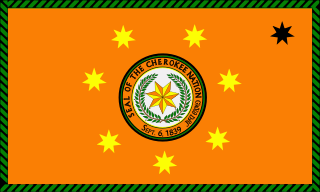
The Cherokee Nation, also known as the Cherokee Nation of Oklahoma, is the largest of three Cherokee federally recognized tribes in the United States. It includes people descended from members of the Old Cherokee Nation who relocated, due to increasing pressure, from the Southeast to Indian Territory and Cherokee who were forced to relocate on the Trail of Tears. The tribe also includes descendants of Cherokee Freedmen, Absentee Shawnee, and Natchez Nation. As of 2023, over 450,000 people were enrolled in the Cherokee Nation.

William Potter Ross, also known as Will Ross, was the Principal Chief of the Cherokee Nation 1866-1867 and 1872-1875. Born to a Scottish father and a mixed-blood Cherokee mother, he was raised in a bilingual home. Ross attended English-speaking schools. He attended Princeton University, where he graduated first in his class in 1844.

Lewis Downing, also known by his Cherokee name ᎷᏫ ᏌᏩᎾᏍᎩ ("Lewie-za-wau-na-skie") served as Chief of the Cherokee Nation from 1867 to 1872. After the death of John Ross, he was a compromise candidate who was elected to a full term as Principal Chief. Downing worked to heal divisions in the tribe following removal to the Indian Territory and the American Civil War. He was elected to a second term in 1871, but died in 1872, after a two-week battle with pneumonia. The Cherokee Council chose William P. Ross as his successor.

The Cherokee Heritage Center is a non-profit historical society and museum campus that seeks to preserve the historical and cultural artifacts, language, and traditional crafts of the Cherokee. The Heritage center also hosts the central genealogy database and genealogy research center for the Cherokee People. The Heritage Center is located on the site of the mid-19th century Cherokee Seminary building in Park Hill, Oklahoma, a suburb of Tahlequah, and was constructed near the old structure. It is a unit of the Cherokee National Historical Society and is sponsored by the Cherokee Nation, the United Keetoowah Band of Cherokee Indians, and other area tribes. The center was originally known as Tsa-La-Gi but is now known as the Cherokee Heritage Center.

Bacone College, formerly Bacone Indian University, is a Private college in Muskogee, Oklahoma. Founded in 1880 as the Indian University by missionary Almon C. Bacone, it was originally affiliated with the mission arm of what is now American Baptist Churches USA. Renamed as Bacone College in the early 20th century, it is the oldest continuously operated institution of higher education in Oklahoma. The liberal arts college has had strong historic ties to several tribal nations, including the Muscogee and Cherokee. The Bacone College Historic District has been on the National Register of Historic Places listings in Muskogee County, Oklahoma since 2014.
Sequoyah High School is a Native American boarding school serving students in grades 7 through 12, who are members of a federally recognized Native American tribe. The school is located in Park Hill, Oklahoma, with a Tahlequah post office address, and is a Bureau of Indian Education (BIE) grant school operated by the Cherokee Nation.

Dennis Wolf Bushyhead was a leader in the Cherokee Nation after they had removed to Indian Territory. Born into the Wolf Clan, he was elected as Principal Chief, serving two terms, from 1879 to 1887.
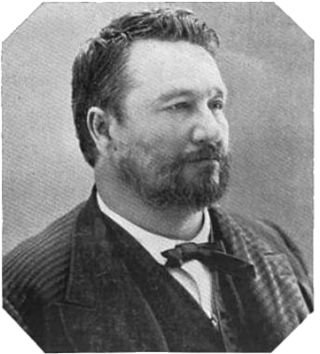
Joel Bryan Mayes was Principal Chief of the Cherokee Nation.

Samuel Houston Mayes of Scots/English-Cherokee descent, was elected as Principal Chief of the Cherokee Nation in Indian Territory, serving from 1895 to 1899. His maternal grandfather belonged to the Deer clan, and his father was allied with members of the Cherokee Treaty Party in the 1830s, such as the Adair men, Elias Boudinot, and Major Ridge. In the late nineteenth century, his older brother Joel B. Mayes was elected to two terms as Chief of the Cherokee.
The Cherokee Female Seminary was built by the Cherokee Nation in 1889 near Tahlequah, Indian Territory. It replaced their original girls' seminary, the first Cherokee Female Seminary, that had burned down on Easter Sunday two years before. The Seminary was listed on the National Register of Historic Places in 1973.
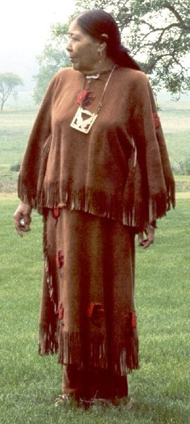
The Delaware Tribe of Indians, formerly known as the Cherokee Delaware or the Eastern Delaware, based in Bartlesville, Oklahoma, is one of three federally recognized tribes of the Lenape people in the United States. The others are the Delaware Nation based in Anadarko, Oklahoma, and the Stockbridge-Munsee Community of Wisconsin. More Lenape or Delaware people live in Canada.
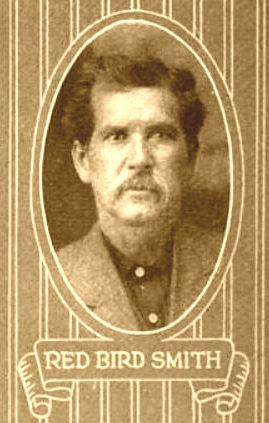
Redbird Smith (1850–1918) was a traditionalist and political activist in the Cherokee Nation in Indian Territory. He helped found the Nighthawk Keetoowah Society, whose members revitalized traditional spirituality among the Cherokee from the mid-19th century to the early 20th century.

The Cherokee Nation was a legal, autonomous, tribal government in North America recognized from 1794 to 1907. It was often referred to simply as "The Nation" by its inhabitants. The government was effectively disbanded in 1907, after its land rights had been extinguished, prior to the admission of Oklahoma as a state. During the late 20th century, the Cherokee people reorganized, instituting a government with sovereign jurisdiction known as the Cherokee Nation. On July 9, 2020, the United States Supreme Court ruled that the Muscogee (Creek) Nation had never been disestablished in the years before allotment and Oklahoma Statehood.
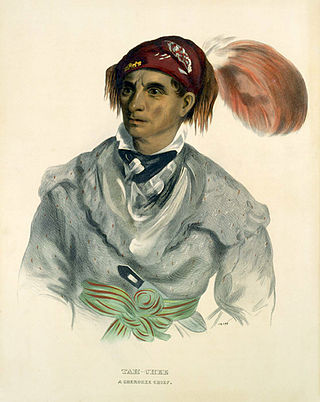
William Dutch or Tahchee was a prominent leader of the Cherokee "Old Settlers" in the American West. He was renowned as a notorious enemy of the Osage tribe, and a spokesman for the Cherokee.
References
- Conley, Robert J. A Cherokee Encyclopedia. Albuquerque: University of New Mexico Press, 2007. ISBN 978-0-8263-3951-5.
- Foreman, Grant. The Five Civilized Tribes: Cherokee, Chickasaw, Choctaw, Creek, Seminole. Norman: University of Oklahoma Press, 1982. ISBN 978-0-8061-0923-7.